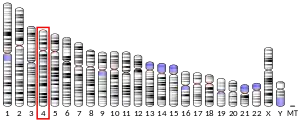| MFSD8 | |||||||||||||||||||||||||||||||
|---|---|---|---|---|---|---|---|---|---|---|---|---|---|---|---|---|---|---|---|---|---|---|---|---|---|---|---|---|---|---|---|
| Identifiers | |||||||||||||||||||||||||||||||
| Aliases | MFSD8, CLN7, CCMD, major facilitator superfamily domain containing 8 | ||||||||||||||||||||||||||||||
| External IDs | OMIM: 611124 MGI: 1919425 HomoloGene: 115814 GeneCards: MFSD8 | ||||||||||||||||||||||||||||||
| |||||||||||||||||||||||||||||||
| |||||||||||||||||||||||||||||||
| |||||||||||||||||||||||||||||||
| Wikidata | |||||||||||||||||||||||||||||||
| |||||||||||||||||||||||||||||||
Major facilitator superfamily domain containing 8 also called MFSD8 is a protein that in humans is encoded by the MFSD8 gene.[5] MFSD8 is an atypical SLC,[6][7] thus a predicted SLC transporter. It clusters phylogenetically to the Atypical MFS Transporter family 2 (AMTF2).[7]
Function
MFSD8 is a ubiquitous integral membrane protein which contains a transporter domain and a major facilitator superfamily (MFS) domain. Other members of the major facilitator superfamily transport small solutes through chemiosmotic ion gradients. The substrate transported by this protein is unknown. The protein, likely localizes to lysosomal membranes.[8]
Clinical significance
Mutations in the MFSD8 gene have been of neuronal ceroid lipofuscinosis.[9]
References
- 1 2 3 GRCh38: Ensembl release 89: ENSG00000164073 - Ensembl, May 2017
- 1 2 3 GRCm38: Ensembl release 89: ENSMUSG00000025759 - Ensembl, May 2017
- ↑ "Human PubMed Reference:". National Center for Biotechnology Information, U.S. National Library of Medicine.
- ↑ "Mouse PubMed Reference:". National Center for Biotechnology Information, U.S. National Library of Medicine.
- ↑ Siintola E, Topcu M, Aula N, Lohi H, Minassian BA, Paterson AD, Liu XQ, Wilson C, Lahtinen U, Anttonen AK, Lehesjoki AE (July 2007). "The novel neuronal ceroid lipofuscinosis gene MFSD8 encodes a putative lysosomal transporter". Am. J. Hum. Genet. 81 (1): 136–46. doi:10.1086/518902. PMC 1950917. PMID 17564970.
- ↑ Perland, Emelie; Fredriksson, Robert (March 2017). "Classification Systems of Secondary Active Transporters". Trends in Pharmacological Sciences. 38 (3): 305–315. doi:10.1016/j.tips.2016.11.008. ISSN 1873-3735. PMID 27939446.
- 1 2 Perland, Emelie; Bagchi, Sonchita; Klaesson, Axel; Fredriksson, Robert (September 2017). "Characteristics of 29 novel atypical solute carriers of major facilitator superfamily type: evolutionary conservation, predicted structure and neuronal co-expression". Open Biology. 7 (9): 170142. doi:10.1098/rsob.170142. ISSN 2046-2441. PMC 5627054. PMID 28878041.
- ↑ "Entrez Gene: MFSD8".
- ↑ Stogmann E, El Tawil S, Wagenstaller J, et al. (February 2009). "A novel mutation in the MFSD8 gene in late infantile neuronal ceroid lipofuscinosis". Neurogenetics. 10 (1): 73–7. doi:10.1007/s10048-008-0153-1. PMID 18850119. S2CID 22802019.
External links
Further reading
- Aiello C, Terracciano A, Simonati A, et al. (2009). "Mutations in MFSD8/CLN7 are a frequent cause of variant-late infantile neuronal ceroid lipofuscinosis". Hum. Mutat. 30 (3): E530–40. doi:10.1002/humu.20975. PMID 19177532. S2CID 205918953.
- Kousi M, Siintola E, Dvorakova L, et al. (2009). "Mutations in CLN7/MFSD8 are a common cause of variant late-infantile neuronal ceroid lipofuscinosis". Brain. 132 (Pt 3): 810–9. doi:10.1093/brain/awn366. PMID 19201763.
- Wheeler RB, Sharp JD, Mitchell WA, et al. (1999). "A new locus for variant late infantile neuronal ceroid lipofuscinosis-CLN7". Mol. Genet. Metab. 66 (4): 337–8. doi:10.1006/mgme.1999.2804. PMID 10191125.
- Otsuki T, Ota T, Nishikawa T, et al. (2005). "Signal sequence and keyword trap in silico for selection of full-length human cDNAs encoding secretion or membrane proteins from oligo-capped cDNA libraries". DNA Res. 12 (2): 117–26. doi:10.1093/dnares/12.2.117. PMID 16303743.
- Strausberg RL, Feingold EA, Grouse LH, et al. (2002). "Generation and initial analysis of more than 15,000 full-length human and mouse cDNA sequences". Proc. Natl. Acad. Sci. U.S.A. 99 (26): 16899–903. Bibcode:2002PNAS...9916899M. doi:10.1073/pnas.242603899. PMC 139241. PMID 12477932.
- Kimura K, Wakamatsu A, Suzuki Y, et al. (2006). "Diversification of transcriptional modulation: large-scale identification and characterization of putative alternative promoters of human genes". Genome Res. 16 (1): 55–65. doi:10.1101/gr.4039406. PMC 1356129. PMID 16344560.
- Mitchell WA, Wheeler RB, Sharp JD, et al. (2001). "Turkish variant late infantile neuronal ceroid lipofuscinosis (CLN7) may be allelic to CLN8". Eur. J. Paediatr. Neurol. 5 Suppl A: 21–7. doi:10.1053/ejpn.2000.0429. PMID 11589000.
- Aldahmesh MA, Al-Hassnan ZN, Aldosari M, Alkuraya FS (2009). "Neuronal ceroid lipofuscinosis caused by MFSD8 mutations: a common theme emerging". Neurogenetics. 10 (4): 307–11. doi:10.1007/s10048-009-0185-1. PMID 19277732. S2CID 36438803.
- Brandenberger R, Wei H, Zhang S, et al. (2004). "Transcriptome characterization elucidates signaling networks that control human ES cell growth and differentiation". Nat. Biotechnol. 22 (6): 707–16. doi:10.1038/nbt971. PMID 15146197. S2CID 27764390.
This article incorporates text from the United States National Library of Medicine, which is in the public domain.



